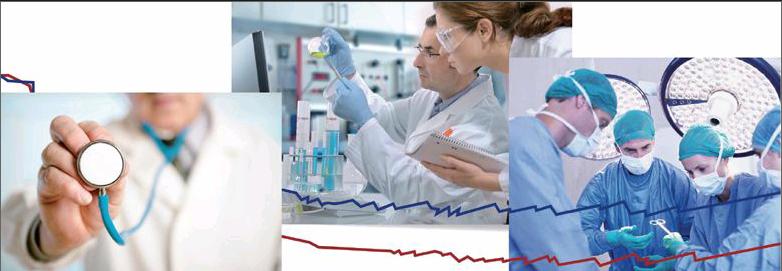一位患癌医生的自白
文/Paul+Kalanithi+译/辛献云



Time is shortening. But every day that I challenge this cancer and survive is a victory for me.
—Ingrid Bergman (英格丽·褒曼,好莱坞演员)
As soon as the CT scan was done, I began reviewing the images. The diagnosis was immediate: masses matting1) the lungs and deforming the spine2). Cancer. In my neurosurgical training, I had reviewed hundreds of scans for fellow doctors to see if surgery offered any hope. Id scribble3) in the chart “Widely metastatic4) disease—no role for surgery,” and move on. But this scan was different: It was my own.
I have sat with countless patients and families to discuss grim prognoses5): Its one of the most important jobs physicians have. Its easier when the patient is 94, in the last stages of dementia6) and has a severe brain bleed. For young people like me—I am 36—given a diagnosis of cancer, there arent many words. My standard pieces include “its a marathon, not a sprint7), so get your daily rest” and “illness can drive a family apart or bring it together—be aware of each others needs and find extra support.”
I learned a few basic rules. Be honest about the prognosis but always leave some room for hope. Be vague but accurate: “days to a few weeks,” “weeks to a few months,” “months to a few years,” “a few years to a decade or more.” We never cite detailed statistics, and usually advise against Googling survival numbers, assuming the average patient doesnt possess a nuanced understanding of statistics.
People react differently to hearing “Procedure X has a 70 percent chance of survival” and “Procedure Y has a 30 percent chance of death.” Phrased that way, people flock to Procedure X, even though the numbers are the same. When a close friend developed pancreatic8) cancer, I became the medical maven9) to a group of people who were sophisticated statisticians. I still dissuaded10) them from looking up the statistics, saying five-year survival curves are at least five years out of date. Somehow I felt that the numbers alone were too dry, or that a physicians daily experience with illness was needed for context. Mostly, I felt that impulse: Keep a measure of hope.
These survival curves, called Kaplan-Meier curves11), are one way we measure progress in cancer treatment, plotting the number of patients surviving over time. For some diseases, the line looks like an airplane gently beginning its descent; for others, like a dive bomber12). Physicians think a lot about these curves, their shape, and what they mean. In brain-cancer research, for example, while the numbers for average survival time havent changed much, theres an increasingly long tail on the curve, indicating a few patients are living for years. The problem is that you cant tell an individual patient where she is on the curve. Its impossible, irresponsible even, to be more precise than you can be accurate.
One would think, then, that when my oncologist13) sat by my bedside to meet me, I would not immediately demand information on survival statistics. But now that I had traversed14) the line from doctor to patient, I had the same yearning for the numbers all patients ask for. I hoped she would see me as someone who both understood statistics and the medical reality of illness, that she would give me certainty, the straight dope15). I could take it. She flatly refused: “No. Absolutely not.” She knew very well I could—and did—look up all the research on the topic. But lung cancer wasnt my specialty, and she was a world expert. At each appointment, a wrestling match began, and she always avoided being pinned down to any sort of number.
Now, instead of wondering why some patients persist in asking statistics questions, I began to wonder why physicians obfuscate16) when they have so much knowledge and experience. Initially when I saw my CT scan, I figured I had only a few months to live. The scan looked bad. I looked bad. Id lost 30 pounds, developed excruciating17) back pain and felt more fatigued every day. My tests revealed severely low protein levels and low blood counts consistent with the body overwhelmed, failing in its basic drive to sustain itself.
For a few months, Id suspected I had cancer. I had seen a lot of young patients with cancer. So I wasnt taken aback18). In fact, there was a certain relief. The next steps were clear: Prepare to die. Cry. Tell my wife that she should remarry, and refinance the mortgage. Write overdue letters to dear friends. Yes, there were lots of things I had meant to do in life, but sometimes this happens: Nothing could be more obvious when your days work includes treating head trauma and brain cancer.
But on my first visit with my oncologist, she mentioned my going back to work someday. Wasnt I a ghost? No. But then how long did I have? Silence.
Of course, she could not stop my intense reading. Poring over studies, I kept trying to find the one that would tell me when my number would be up19). The large general studies said that between 70 and 80 percent of lung cancer patients would die within two years. They did not allow for much hope. But then again, most of those patients were older and heavy smokers. Where was the study of nonsmoking 36-year-old neurosurgeons? Maybe my youth and health mattered? Or maybe my disease was found so late, had spread so far, and I was already so far gone that I was worse off than those 65-year-old smokers.
Many friends and family members provided anecdotes along the lines of20) my-friends-friends-moms-friend or my-uncles-barbers-sons-tennis-partner has this same kind of lung cancer and has been living for 10 years. Initially I wondered if all the stories referred to the same person, connected through the proverbial21) six degrees22). I disregarded them as wishful thinking, baseless delusion23). Eventually, though, enough of those stories seeped in through the cracks of my studied realism.
And then my health began to improve, thanks to a pill that targets a specific genetic mutation24) tied to my cancer. I began to walk without a cane and to say things like, “Well, its pretty unlikely that Ill be lucky enough to live for a decade, but its possible.” A tiny drop of hope.
In a way, though, the certainty of death was easier than this uncertain life. Didnt those in purgatory25) prefer to go to hell, and just be done with it? Was I supposed to be making funeral arrangements? Devoting myself to my wife, my parents, my brothers, my friends, my adorable niece? Writing the book I had always wanted to write? Or was I supposed to go back to negotiating my multiyear job offers?
The path forward would seem obvious, if only I knew how many months or years I had left. Tell me three months, Id just spend time with family. Tell me one year, Id have a plan (write that book). Give me 10 years, Id get back to treating diseases. The pedestrian26) truth that you live one day at a time didnt help: What was I supposed to do with that day? My oncologist would say only: “I cant tell you a time. Youve got to find what matters most to you.”
I began to realize that coming face to face with my own mortality, in a sense, had changed both nothing and everything. Before my cancer was diagnosed, I knew that someday I would die, but I didnt know when. After the diagnosis, I knew that someday I would die, but I didnt know when. But now I knew it acutely. The problem wasnt really a scientific one. The fact of death is unsettling. Yet there is no other way to live.
The reason doctors dont give patients specific prognoses is not merely because they cannot. Certainly, if a patients expectations are way out of the bounds of probability—someone expecting to live to 130, or someone thinking his benign skin spots are signs of impending death—doctors are entrusted to bring that persons expectations into the realm of reasonable possibility.
But the range of what is reasonably possible is just so wide. Based on todays therapies, I might die within two years, or I might make it to 10. If you add in the uncertainty based on new therapies available in two or three years, that range may be completely different. Faced with mortality, scientific knowledge can provide only an ounce of certainty: Yes, you will die. But one wants a full pound of certainty, and that is not on offer.
What patients seek is not scientific knowledge doctors hide, but existential authenticity each must find on her own. Getting too deep into statistics is like trying to quench27) a thirst with salty water. The angst28) of facing mortality has no remedy in probability.
I remember the moment when my overwhelming uneasiness yielded. Seven words from Samuel Beckett29), a writer Ive not even read that well, learned long ago as an undergraduate, began to repeat in my head, and the seemingly impassable30) sea of uncertainty parted: “I cant go on. Ill go on.” I took a step forward, repeating the phrase over and over: “I cant go on. Ill go on.” And then, at some point, I was through.
I am now almost exactly eight months from my diagnosis. My strength has recovered substantially. In treatment, the cancer is retreating. I have gradually returned to work. Im knocking the dust off scientific manuscripts. Im writing more, seeing more, feeling more. Every morning at 5:30, as the alarm clock goes off, and my dead body awakes, my wife asleep next to me, I think again to myself: “I cant go on.” And a minute later, I am in my scrubs, heading to the operating room, alive: “Ill go on.”
CT扫描一完成,我就开始审视影像。诊断结果立即得出:大量物质正积聚在肺部,使脊椎变形。是癌症!在我所接受的神经外科训练中,我已经为同事查看过数百个扫描结果,以确定手术是否能带来一丝希望。我常常会在表格里潦草地写下“疾病已广泛转移——手术无作用”,然后该干吗干吗去。但这次扫描不一样:这是我自己的图像。
我曾经同无数的病人及家属坐在一起讨论过严峻的预后情况:这是医生们所要做的最重要的工作之一。如果病人已94岁高龄,处于老年痴呆症晚期并伴有严重的脑出血,事情就比较简单了。但对于像我这样的年轻人——我36岁——被诊断为癌症,真是没有太多可以说的。我的标准回应包括“这是一场马拉松,而非短跑比赛,所以每天都要休息”,以及“疾病可以拆散一个家庭,也可以使一个家庭更为齐心协力——要留意彼此的需求,寻找额外的支持”。
我掌握了几条基本的规则。对预后要实话实说,但要始终留有希望的余地。可以说得含糊一些,但一定要准确:“从几天到几周”,“从几周到几个月”,“从几个月到几年”,“从几年到十年或更久”。我们从不引用详细的统计数据,通常也不建议在谷歌上搜索存活数据,因为我们认为普通患者对统计数据不具备细致入微的理解力。
如果告诉病人“采用X流程有70%的几率存活”,“采用Y流程有30%的几率死亡”,那么病人的反应是不同的。听到这样的话,人们会一窝蜂地选择X流程,即使两者包含的数据是相同的。有一次,一个好朋友得了胰腺癌,在一群动不动就拿统计数据说事的人面前,我只好担负起医学专家的角色。我仍然劝他们不要查看统计数据,告诉他们五年存活曲线至少已过时五年。不知为什么,我觉得仅仅拿数字说事太过乏味,觉得还需要参考医生处理疾病的日常经验才行。多数时候,我感到有一种冲动,那就是保持一定程度的希望。
这种存活曲线叫做卡普兰-迈耶曲线,是我们评估癌症治疗进展的一种方式,绘制的是在一定时间内患者的存活数量。对某些疾病而言,该曲线看上去就像一架缓缓降落的飞机;而对另一些疾病而言,它就像是一架俯冲直下的轰炸机。医生们会对这些曲线、曲线形状及其所代表的意义进行大量思考。譬如,在脑肿瘤研究中,虽然达到平均存活时间的人数并没有发生多大变化,但在曲线上有一条越来越长的尾巴,表明一些患者会存活数年之久。问题是,你无法告诉某一特定的患者她在这条曲线上的位置。你只能尽力地做到准确,而要做到更加精确是不可能的,甚至是不负责任的。
那么,有人也许会想,当肿瘤医师坐在我的床边为我诊病时,我应该不会立刻询问她关于存活数据的信息。但既然我已经从医生变成了患者,我也和所有病人一样渴望了解存活信息。我希望她把我看成一个既懂得统计数据又懂得疾病医理的人,希望她可以告诉我确定的事实,最直接的内幕消息。我还是能接受的。但她一口回绝了:“不行,绝对不行。”她非常了解我可能会查阅关于这一课题的所有研究——事实上我也确实查阅了。但肺癌不是我的专长,而她则是一位世界级专家。每一次约见都是一场较量,而她总是避免明确吐露任何数字。
如今,我已不再思考为什么有的患者非要询问统计数据的问题,相反,我开始思考为什么医生拥有那么丰富的学识和经验却还是含糊其辞。最初,当我看到自己的CT扫描图像时,我想我只有几个月可活了。图像看起来很糟。我看起来也很糟。我体重减了30磅,背部疼得像受刑一样,一天比一天感到疲惫。检查结果表明,我的蛋白质水平严重低下,血球计数减少,这同我不堪折磨的身体状况是一致的,它已失去了自我维护的基本动力。
数月以来,我一直怀疑我得了癌症。我见过太多年轻的癌症患者,所以我并不感到震惊。事实上,我反而感到某种解脱。接下来要做的事情很明确:等死。痛哭。告诉我妻子她应该再婚,还要再为房贷筹备资金。给好朋友们写早就该写的信件。是的,生活中我想做而未做的事情太多了,但有时这无法避免。当你每天要做的事情包括治疗颅脑损伤和脑肿瘤时,这一点就再明显不过了。
但当我第一次去见我的肿瘤医生时,她提到我某天可以回去工作。我不是已经被判死刑了吗?没有。那么我还能活多长时间呢?她沉默了。
当然,她无法阻止我如饥似渴地查阅资料。在研读资料时,我一直想找到一篇文章能够告诉我还有多少日子可走。大多数一般性研究都说70%~80%的肺癌患者会在两年内死亡。它们都没有给我带来多少希望。但话又说回来,那些患者绝大多数都比我年龄大,而且还是重度烟民。有没有对不抽烟的36岁神经外科医生的研究资料呢?也许我的年轻和健康会发挥关键作用呢?又或许我的疾病发现得太晚,早已大面积扩散,我已经病入膏肓,远不如那些65岁的烟民呢?
很多朋友和家人会向我讲述某某某的奇妙故事,诸如我朋友的朋友的妈妈的朋友或者我叔叔的理发师的儿子的网球伙伴得过同样的肺癌,但已经活了十年了。最初,我猜想所有这些故事指的都是同一个人吧,通过著名的“六度分隔理论”联系到一起了。我对这些奇闻不屑一顾,认为它们不过是一厢情愿的想法,是毫无根据的幻想。不过最后,这类传闻还是有不少透过我注重研究、实事求是的观念的“裂缝”渗透进来。
接着,我的健康状况开始好转,这多亏了一种药物,它是与我癌症相关的某种基因突变的克星。我已可以不用拐杖就能走路了,也开始说一些这样的话:“要说我有幸能再活十年,那不太可能,但也不是完全不可能。”终于还是有了一丝希望。
但是,从某种程度上说,难逃一死的滋味总要胜过生死未卜的煎熬。那些在炼狱中受尽煎熬的人不都宁愿赶紧下地狱了结一切吗?我是不是应该安排好自己的葬礼呢?是不是应该把所有时间都留给我的妻子、父母、兄弟、朋友,还有我可爱的侄女呢?是不是应该把那本我一直想写的书写出来呢?或者,我是不是应该回去商谈我多年的工作机会呢?
倘若我知道自己还有几个月或者几年的日子,前方的道路就会明确得多。若告诉我还有三个月,我将仅与家人共度时光。若告诉我还有一年,我将完成一个计划(写那本书)。给我十年时间,我将会重操旧业,给病人看病。不要对我说活一天算一天这种老掉牙的道理,没用——这一天我该做什么?我的肿瘤医生只会说:“我无法告诉你确定的时间。你必须找到对你来说最重要的事情。”
我开始意识到,在某种意义上,直面自己的死亡这件事既可以说什么都没有改变,也可以说改变了一切。在癌症被确诊前,我知道总有一天自己会死去,但不知道会是何时。确诊之后,我还是知道某一天自己会死去,但还是不知何时。只不过现在我更加敏锐地知道这一点。这实际上不是一个科学问题。死亡的存在令人心神不安。但人生就是如此,别无选择。
医生不给患者提供明确的预测,不仅仅是因为他们无法做到。当然,如果一个患者的期待远远超出了可能性范围——比如有人希望自己活到130岁,或者某人认为他的良性皮肤斑是死亡将至的信号——医生就有责任将此人的期待引入合理的可能性范围。
但合理的可能性范围非常宽泛。根据目前的治疗手段,我可能两年内就会死去,也可能会撑到十年。如果再加上未来两三年内新的治疗手段所带来的不确定性,这个范围又会完全不同。面对死亡的命运,科学知识仅能提供微不足道的确定性:没错,人必有一死。但人们总想获得百分之百的确定性,而那是无法满足的。
患者所寻求的并不是医生隐瞒的科学知识,而是存在的真实性,这样的真实性是每个人必须独自去发现的。过于纠结于统计数据无异于饮鸩止渴。可能性并不是治疗死亡恐惧症的灵丹妙药。
我还记得那几乎将我压垮的紧张烟消云散的那一刻。塞缪尔·贝克特——一个我甚至还没有好好读过的作家——说过的两句话救了我。这两句话是我很久以前上大学时学过的,最近开始萦绕在我脑海中:“我撑不下去了。我一定要撑下去。”那看似不可逾越的不确定之鸿沟顿时消失。我向前迈出一步,一遍又一遍地重复着这两句话:“我撑不下去了。我一定要撑下去。”终于,在某一时刻,我闯过来了。
现在,距我确诊为癌症差不多有整整八个月时间了。我的体力已大体复原。通过治疗,癌症正在消退。我已渐渐开始做一些工作。我弹掉科学手稿上的灰尘,坚持多写、多看、多感受。每天早上五点半,当闹钟响起,我沉睡的身体醒来,看着妻子在身旁安睡,我又一次心中暗想:“我撑不下去了。”但一分钟之后,我又焕发了生命的活力,穿上外科手术服,朝着手术室走去:“我一定要撑下去!”
1. mat [m?t] vt. (使) 缠结,(使) 交织在一起
2. spine [spa?n] n. 脊柱,脊椎
3. scribble [?skr?b(?)l] vt. 潦草书写
4. metastatic [?met??st?t?k] adj. (癌细胞等)转移性的
5. prognosis [pr?ɡ?n??s?s] n. [医]预后(指根据症状对疾病后果的预测),其复数形式为prognoses。
6. dementia [d??men??] n. [医]痴呆
7. sprint [spr?nt] n. 短(距离赛)跑
8. pancreatic [?p??kri??t?k] adj. [解]胰的
9. maven [?me?v?n] n.〈美口〉专家,内行
10. dissuade [d??swe?d] vt. 劝……不要做某事,劝阻
11. Kaplan-Meier curve:[医]卡普兰-迈耶曲线,统计分析癌症患者的存活时间的曲线
12. bomber [?b?m?(r)] n. 轰炸机
13. oncologist [?n?k?l?d?ist] n. 肿瘤学家
14. traverse [tr??v??(r)s] vt. 沿……来回移动;在……来回走动
15. dope [d??p] n. (内幕)消息;密报
16. obfuscate [??bf??ske?t] vi. (尤指故意地) 模糊处理
17. excruciating [?k?skru??i?e?t??] adj. 受折磨的;极痛苦的
18. take aback:(常用被动语态)使吃惊;使困惑
19. sb.s number is up:某人死期将到(幽默用法)
20. along the lines of:类似于,与……近似
21. proverbial [pr??v??(r)bi?l] adj. 出名的,众所周知的
22. six degrees:六度分隔理论(Six Degrees of Separation),又称为“小世界效应”,指的是世界上所有互不相识的人只需要通过很少的中间人就能建立起联系。
23. delusion [d??lu??(?)n] n. 错觉;谬见;误会
24. mutation [mju??te??(?)n] n. 变化;变异
25. purgatory [?p??(r)ɡ?t(?)ri] n. 炼狱
26. pedestrian [p??destri?n] adj. 缺乏想象力的,平淡无奇的,乏味的
27. quench [kwent?] vt. 解(渴);止(渴)
28. angst [??st] n. 忧虑;疑惧
29. Samuel Beckett:塞缪尔·贝克特(1906~1989),20世纪法国作家,荒诞派戏剧的重要代表人物,创作的领域包括戏剧、小说和诗歌,代表作为《等待戈多》(Waiting for Godot)。1969年,他获得诺贝尔文学奖。
30. impassable [?m?pɑ?s?b(?)l] adj. 不能通行的;不能逾越的

